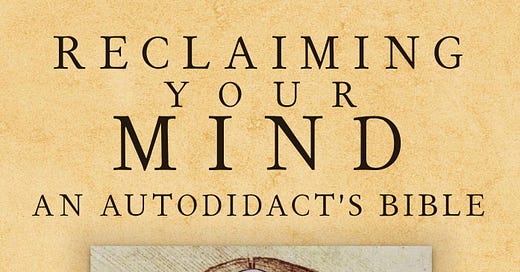This is the ninth installment of the serial of my forthcoming book Reclaiming Your Mind: An Autodidact’s Bible. As with other installments, part of it is behind the paywall. Become one of my supporters to get the whole thing.
Catch up on earlier installments here:
#1, #2, #3, #4, #5, #6, #7, #8
If your email client chokes on this post, find the whole thing at http://jdanielsawyer.substack.com
Continuing with our tour of basic cognitive tools…
Chapter 1
Outfitting Yourself: The Basics (continued)
Stealing the Low-Hanging Fruit
One of the great strengths of the Western tradition is its willingness to, well, give the finger to tradition—a strength it has passed along to many places in the developed world, whether Western or not. But your trek through Pope’s Alps did not begin from nowhere. You exist in a context, much as you might like to think otherwise.
Those of us who were born after World War Two have embraced this strength with more-than-usual gusto. Its liberation, particularly, we’ve found intoxicating—not just in our youth, but on into middle age and beyond. Our heroes gave the finger to tradition and revolutionized the world—Copernicus, Edison, Brin,1 Galileo, Newton, Franklin, Einstein, Darwin, Smith, Luther, King, Roosevelt, Gutenberg, Gates, Ford, and on, and on, and on. These people (and thousands more besides) made the world what it is by bucking convention, by thinking differently, by breaking bounds and having the guts to not be tethered by the rules and norms that govern the rest of us.
They were singular geniuses, unfettered by the petty concerns of their time.
Weren’t they?
Consider for a moment what every one of those people really did. Their “revolutions” didn’t come out of nowhere. They were each an incremental step—genius and inventive and insightful/inspired, for sure, but an incremental step nonetheless—taken within a tradition. They each had a deep understanding of the tradition they were working within. Their revolutions were all produced by using the tools and thought-forms implicit in those traditions, but in novel ways.
In every above case, those traditions included ways of thinking that encouraged analysis and intuition, values that encouraged standing up against consensus and tradition, and social (or economic) circumstances that rewarded risk taking and punished failure.
But more important than that, each of these people grew up bathing in a cultural tradition filled with humanistic concerns—especially a cautious and cynical picture of human nature and a belief in the ability of the individual to change the course of events.
Or, failing that, the nobility of the attitude: “Die trying.”
They were suckled on tales of great martyrs for truth and conscience—like Socrates or St. Peter—and of take-no-prisoners rule breakers who built empires, like Caesar and Alexander. Parables of prudence and courage and dignity, from those of Homer to Samuel to Sophocles to Plutarch. The heroes of their civilization embodied the virtues of their civilization. That’s what heroes do.
In other words, before they ventured out into the wider world, they first learned how to walk and hike and run and climb on their home soil. They plucked and feasted upon its low-hanging fruit.
All cultures have this kind of low-hanging fruit, though its flavor differs from place to place. This is because cultures are not ad hoc social constructs built to serve the interests of the powerful; they are evolved creatures formed by the same trial-and-error process that creates all structures in the universe. In any given generation, there’s a decent chance that some parts of a given culture are out of sync—no longer fit for purpose, or out of step with the needs and realities of the day—and those are the places that give when you push against them. That’s how you find the holes in the glass box.
The human appendix is a vestigial organ. Originally an integral part of the digestive system when our ancestors were herbivores, now it sits in our gut, hanging off our intestines like a little worm, its only apparent purpose being to get inflamed and kill us from time to time. When I had mine out at the age of twelve, the doctor told me that all the appendix did was to function as a Petri dish for infections. He was confident about that, because three hundred years of anatomical research and medical science had proved there was nothing in there but a bunch of bacteria.
Turns out, though, that this was half the story.




